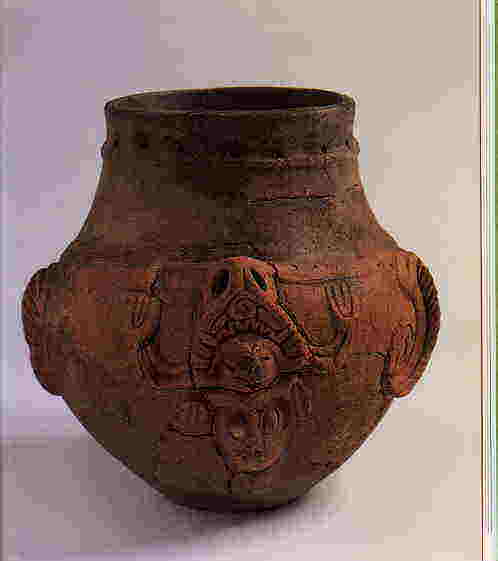Right: the bottom part of the pot on the
left
Above: Hayashi-ouji Site in Atsugi City,
Kanagawa Prefecture
At the bottom of the pot is a face
similar to the face above, and it also has
hands and body which have already come out
of the pot.
Is the pot below also a Shussan-doki?
There
are two interpretations of this drawing. One
is that the woman has just borne a baby But
an archaeologist Makoto Watanabe thinks differently,
and Professor Atsuhiko Yoshida agrees with
him. They think that in this picture
a baby is going up into the body of the woman.
One
reason is that her breast is not big enough.
like that of a woman who has just become
a mother and is going to feed a baby. As
it is the case in other cultures too, woman's
breast is usually exaggerated when it is
a symbol of motherhood. So the woman
here is not a mother yet, or has not been
pregnant for months getting prepared to become
a mother.
The
other reason is based on Jomon people's way
of burying their infants. Jomon people
put an infant's dead body into a pot and
buried it at the entrance of their house.
Pots with an infant's bones have been
excavated there. Those pots were sometimes
found buried upside down, but in that case
the bottom of pots was broken, or there was
a hole in the bottom. Archaeologists
and anthropologists in Japan have reached
a conclusion that Jomon people wished their
dead child would get out of the pot and come
back into its mother's womb and be reborn,
so they buried the pot coffin at the entrance
of their house where the mother walked in
and out every day. By burying their
child there, they probably thought they could
make it easy for the child to enter its mother
again. For these reasons, the two scholars
think that though the basic idea about pottery
and childbirth is the same on these two pots,
the latter one is not a Shussan-doki.
The
left pot was excavated at Toudonomiya Site
in Nagano Prefecture. It is 64 centimeters
high, and though it cannot be seen clearly
in the picture here, the right-hand drawing
is on the lower part of its body. The
figure is considered to be a woman.
When it was found, there were two small pots
beside it, one on its right-hand side
and the other on its left-hand side. As there are some burns on its outside,
it probably was used as a cooking pot first,
and then it was used as a coffin.
The above pot has a face on the rim and is
just giving birth to a child. It
is called Shussan-doki, which means "the pot giving birth
to a child." There is an interesting
website on this pot, and you'll find more
information. The URL is http://www.comlink.ne.jp/~stm/English/shussan-eng.html
Shussan-doki : the pot giving birth to a
child

